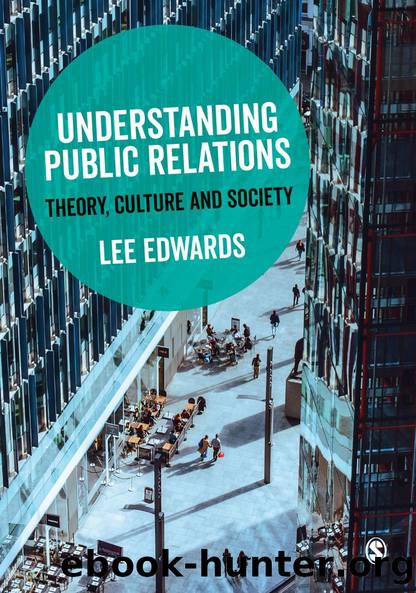Understanding Public Relations by Lee Edwards

Author:Lee Edwards [Edwards, Lee]
Language: eng
Format: epub
Tags: Social Science, Media Studies
ISBN: 9781473913103
Google: d3wDtAEACAAJ
Publisher: SAGE Publications
Published: 2018-06-06T04:38:34+00:00
Chapter 8 Public Relations as an Occupational Field The Professional Project
This chapter moves the focus from an outward-looking analysis of public relations in society to an examination of the internal dynamics of the field. The industry is a justifiable object of research from an economic perspective, since it generates billions of dollars each year in revenue and employs hundreds of thousands of practitioners across the globe (Muzi Falconi, 2006; USC Annenberg Center for Public Relations, 2016). However, economics is not the sole reason for an interest in the occupational field; alongside its financial clout, we should be interested in it because it provides the social and cultural context within which practitionersâ working lives unfold, and its configuration affects the way they work and engage with the world beyond their occupational boundaries (Hodges, 2006).
The public relations industry started to grow rapidly in the 1980s, particularly in developed Western countries. At the time, Keynesian economics was perceived to be failing, and belief in free markets was replacing belief in the state as the best way to manage the economy and society (Harvey, 2005). The subsequent phases of deregulation and the removal of trade barriers increased competition between industries and organisations, and placed new pressure on organisations to inform customers and clients about what they offered and why it was needed. Public relations came into its own in countries and markets across the world as a function that could not only support the marketing of products and services, but also explain their complexities and build organisational reputation to generate competitive advantage in the longer term (Miller and Dinan, 2000, 2007; Moloney, 2006; Sriramesh and VerÄiÄ, 2009). The turn towards neoliberalism and unfettered competition also prompted a shift within organisations, so that their operations became framed less in terms of bureaucratic processes and public service, and more in terms of customers, their needs and their satisfaction (Du Gay and Salaman, 1992). Customer âsovereigntyâ now permeates the operational logic of both private and public sector organisations, and has also supported the growth of public relations, which positions itself as a profession that can help all kinds of organisations understand and engage with their customers more effectively (Edwards, 2014b).
Research into occupational fields1 is long-standing, but has attracted only limited attention in public relations scholarship (but see Pieczka, 2000; LâEtang, 2004; Pieczka and LâEtang, 2006; Trenwith, 2010; Edwards, 2014b; Fitch, 2014). In this chapter I consider the different ways in which the modern public relations industry operates, and reflect on the nature of its professional project, and examine how norms associated with professionalisation and professionalism affect its structures and practices. Public relations fits into the category of knowledge-based occupations, alongside other modern occupations such as management consultancy, project management and recruitment (Muzio et al., 2011; Edwards, 2014b). Knowledge-based occupations have been identified as an important and relatively new group of occupations that differ from traditional professions in that they have a fluid body of occupational knowledge, few barriers to entry, optional professional training and are inseparable from organisations in practice (Kipping et al.
Download
This site does not store any files on its server. We only index and link to content provided by other sites. Please contact the content providers to delete copyright contents if any and email us, we'll remove relevant links or contents immediately.
| Advertising | Consumer Behavior |
| Customer Service | Marketing |
| Public Relations | Sales & Selling |
| Search Engine Optimization |
Influence: The Psychology of Persuasion by Robert B. Cialdini(4715)
The Miracle Morning by Hal Elrod(4636)
The Hacking of the American Mind by Robert H. Lustig(4318)
Pre-Suasion: A Revolutionary Way to Influence and Persuade by Robert Cialdini(4142)
Unlabel: Selling You Without Selling Out by Marc Ecko(3587)
Ogilvy on Advertising by David Ogilvy(3503)
Hidden Persuasion: 33 psychological influence techniques in advertising by Marc Andrews & Matthijs van Leeuwen & Rick van Baaren(3472)
Purple Cow by Seth Godin(3137)
Who Can You Trust? by Rachel Botsman(3086)
Kick Ass in College: Highest Rated "How to Study in College" Book | 77 Ninja Study Skills Tips and Career Strategies | Motivational for College Students: A Guerrilla Guide to College Success by Fox Gunnar(3070)
The Marketing Plan Handbook: Develop Big-Picture Marketing Plans for Pennies on the Dollar by Robert W. Bly(2975)
This Is Marketing by Seth Godin(2969)
I Live in the Future & Here's How It Works by Nick Bilton(2933)
The Power of Broke by Daymond John(2893)
Building a StoryBrand by Donald Miller(2838)
The Tipping Point by Malcolm Gladwell(2820)
The 46 Rules of Genius: An Innovator's Guide to Creativity (Voices That Matter) by Marty Neumeier(2796)
Draw to Win: A Crash Course on How to Lead, Sell, and Innovate With Your Visual Mind by Dan Roam(2732)
Market Wizards by Jack D. Schwager(2643)
